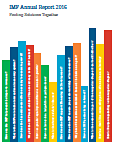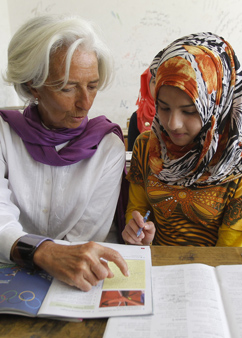Looking Ahead
Key IMF work under way in FY2017 includes a quota review, financial sector assessments, fiscal risk, tax policy, income and gender inequality, climate change, and anti-corruption strategies.
Quota Review

With the previous review becoming effective in January 2016, the IMF turned its attention to completing the next review, which will include a new quota formula.
Financial Sector Assessment

IMF teams will focus their analysis on systemic risks, interconnectedness, and macroprudential and crisismanagement policies.
Fiscal Work

IMF papers explain how countries need a more complete understanding of the potential threats to their fiscal position and the effects of various tax policy designs on macroeconomic stability.
Income and Gender Inequality

IMF work analyzes the linkages between income inequality and growth, the impact of fiscal policy, and gender inequality.
Anti-Corruption Strategies

Priority needs to be given to transparency, the rule of law, and effective institutions.
FY2016 Digital Year in Review
Fifteenth General Review of Quotas
With the January 2016 effectiveness of the Fourteenth General Review of Quotas and the entry into force of the Amendment on the Reform of the Executive Board, the IMF turned its attention to the completion of the next review by October 2017.
The Executive Board’s work on the Fifteenth Review was postponed due to the delay in effectiveness of the package of quota and governance reforms—known as the 2010 reforms— in the context of the Fourteenth Review.
On February 1, 2016, the Executive Board notified the Board of Governors that on January 26, 2016, the Board Reform Amendment entered into force, which would allow the quota increases under the Fourteenth Review to become effective. As the Executive Board had not yet formed a view on the adequacy of quotas in the context of the Fifteenth Review, it proposed that the Board of Governors continue the Fifteenth Review. On February 19, 2016, the Board of Governors adopted a Resolution, expressing regret that the Fifteenth Review had not been completed and calling on the Executive Board to work expeditiously on the Fifteenth Review in line with previous understandings, with the aim of completing the review by the 2017 Annual Meetings.
- Box 4.1: The Quota Formula
-
The current quota formula was agreed in 2008. It includes four variables (GDP, openness, variability, and reserves), expressed in shares of global totals, with the variables assigned weights totaling to 1.0. The formula also includes a compression factor that reduces dispersion in calculated quota shares with a greater impact on large economies than small ones. The formula is:
- CQS = (0.5*Y + 0.3*O + 0.15*V + 0.05*R)k
where:
CQS = calculated quota share; - Y = a blend of GDP converted at market exchange rates and purchasing power parity (PPP) rates averaged over a three-year period. The weights of market-based and PPP GDP are 0.60 and 0.40, respectively;
- O = the annual average of the sum of current payments and current receipts (goods, services, income, and transfers) for a five-year period;
- V = variability of current receipts and net capital flows (measured as the standard deviation from a centered three-year trend over a 13-year period);
- R = 12-month average over one year of official reserves (foreign exchange, SDR holdings, reserve position in the Fund, and monetary gold);
- and k = a compression factor of 0.95. The compression factor is applied to the uncompressed calculated quota shares which are then rescaled to sum to 100.
A comprehensive review of the quota formula was concluded in January 2013 and important progress was made in identifying key elements that could form the basis for a final agreement on a new quota formula. It was agreed that achieving broad consensus on a new quota formula will best be done in the context of the Fifteenth Review rather than on a standalone basis (see “Report of the Executive Board to the Board of Governors on the Outcome of the Quota Formula Review”).
- CQS = (0.5*Y + 0.3*O + 0.15*V + 0.05*R)k
On April 16, 2016, the IMF International Monetary and Financial Committee (IMFC) strongly welcomed “the effectiveness of quota increases” of the Fourteenth Review and of the Amendment on the Reform of the Executive Board. The IMFC called on the Executive Board to “work expeditiously toward completion” of the Fifteenth Review, including a new quota formula, by the 2017 Annual Meetings. The IMFC said it looks forward to a progress report at its meeting during the 2016 Annual Meetings.
The IMFC communique said: “Any realignment under this [Fifteenth] Review is expected to result in increases in the quota shares of dynamic economies in line with their relative positions in the world economy, and hence likely in the share of emerging market and developing countries as a whole. We are committed to protecting the voice and representation of the poorest members. We reaffirm our commitment to maintain a strong, quota-based, and adequately resourced IMF.”
Financial Sector Assessment Program Agenda in FY2017
The Fund’s Financial Sector Assessment Program (FSAP), which assesses the stability of countries’ financial systems, will turn focus on some of the largest and most connected financial systems during FY2017. IMF FSAPs are being conducted in a number of euro area countries for the first time since the transformation of the regulatory and supervisory environment by postcrisis reforms, notably the establishment of the European Banking Union.
In the wake of the global financial crisis, the IMF Executive Board agreed in 2010 that the world’s top 25 financial systems would undergo a mandatory financial check-up every five years. The FSAP underwent its most recent review in FY2015 when the list was expanded to 29 countries. The countries that will conclude their financial stability assessments under the FSAP in FY2017 include Germany and the United Kingdom along with Ireland, Mexico, Russia, and others. The assessment work on China and Spain has begun and will be completed in FY2018.
The FSAP assesses three key components of financial stability in all countries:
- The resilience of banks and other major financial institutions, including through stress tests and analysis of systemic risk factors;
- The quality of financial system oversight—taking into account the macroprudential framework—including banking, securities, insurance, and other subsectors where deemed systemically important; and
- The ability of policymakers and financial safety nets to withstand and respond effectively to deep financial stress.
The overarching goal of FSAP assessments is twofold: to gauge the stability and soundness of the financial sector and to assess its potential contribution to growth and development. The IMF tailors country assessments to analyze issues of particular interest or concern in each country. In FY2017, the IMF teams will focus their analysis on systemic risks, interconnectedness, and macroprudential and crisis-management policies. FSAP findings also provide valuable input to the IMF’s broader surveillance of countries’ economies under the Article IV consultation process.
Fiscal Work in Progress
ANALYZING AND MANAGING FISCAL RISKS: BEST PRACTICES
As underscored by the global financial crisis and the more recent collapse in commodity prices, comprehensive analysis and management of fiscal risks can help ensure sound fiscal public finances and macroeconomic stability. Indeed, over the past quarter century, governments experienced on average an adverse fiscal shock of 6 percent of GDP once every 12 years.
The IMF is playing an important role in supporting improvements in fiscal risk analysis and management among its members. A paper, “Analyzing and Managing Fiscal Risks,” released in early FY2017, explains how countries need a more complete understanding of the potential threats to their fiscal position. A comprehensive and integrated assessment of the potential shocks to government finances, in the form of a fiscal stress test, can help policymakers simulate the effects of shocks to their central forecasts. Comprehensive, reliable, and timely fiscal data covering all public entities, stocks, and flows are a necessary foundation for such analysis.
The paper finds that countries should enhance their capacity to mitigate and manage fiscal risks by expanding their toolkits for fiscal risk management and using instruments to transfer, share, or provision for risks. In doing so, they need to weigh the possible benefits from reducing their exposure to shocks against the financial and other costs of the policies that may be needed.
Countries should make greater use of probabilistic forecasting methods when setting long-term objectives and mediumterm targets for fiscal policy. These can be used to map the uncertainty around medium-term trajectories for public debt. In combination with fiscal stress tests, these tools can provide valuable information about the probabilities that a country will stay within the debt ceilings embedded in their fiscal rules.
The IMF assists the membership in assessing and managing fiscal risks by providing technical assistance on constructing public sector balance sheets, developing institutions and capacity to identify specific fiscal risks and to quantify their potential impact, conducting fiscal stress tests, and integrating risks into the design of medium-term fiscal targets.
TAX POLICY, LEVERAGE, AND MACROECONOMIC STABILITY
A Board paper to be issued in FY2017 on “Tax Policy, Leverage, and Macroeconomic Stability” explores the macroeconomic stability effects of various tax policy designs. One key issue is how the current discrimination between debt and equity in many corporate tax systems affects the leverage choice of firms. By encouraging high corporate debt ratios, such tax incentives may increase firms’ distress and ultimately have implications for macroeconomic stability risks.
The paper examines the effectiveness and efficiency of tax policy reforms that neutralize this debt bias, such as alternative types of restrictions to the deductibility of interest, equivalent deductions for returns on equity, and combinations of the two. Using firm-level data and a newly created database on thin-capitalization rules, the paper empirically assesses the impact of recently introduced policies on corporate debt ratios and examines the impact on broader indicators of corporate default risk. It also assesses the revenue implications of different reforms.
The paper also explores the role of corrective taxes to mitigate financial stability risks: for instance, special bank levies can stimulate capitalization of banks and thus enhance financial stability. Moreover, tax policies such as capital gains taxes, property transaction taxes, and recurrent property taxes can be used to influence property price developments, thereby possibly mitigating risks. These policies are assessed against their broader welfare implications.
Income and Gender Inequality
In recent years, the work of the IMF on macroeconomic issues increasingly has turned to analysis and policy advice on issues related to income inequality and gender inequality. This work has come to be recognized as relevant and important to the policies developed to strengthen economic growth in the Fund’s member countries—developing, emerging market, and advanced economies alike.
In its April 2016 communiqué, the IMFC welcomed work on the issues of “income inequality, gender inequality, [and] financial inclusion,” provided they are “within the Fund’s mandate and where they are macrocritical, and by leveraging the experience of other institutions.”
While the Fund began addressing these areas with groundbreaking research early in the decade, in FY2015 and FY2016 it began to also shift toward applying the findings in pilot countries. The next phase of the work will involve deepening the Fund’s understanding of the policy implications of the analysis in a broader range of countries, and integrating that understanding more fully into policy advice.
INCOME INEQUALITY
Considerable research has been undertaken to analyze the linkages between inequality and growth and discuss the impact of fiscal policy on inequality. Most notably papers on “Inequality and Unsustainable Growth” (2011), “Redistribution, Inequality, and Growth” (2014), and the book Inequality and Fiscal Policy (2015), have recently been published. Work has been extended into the IMF’s flagship publications, notably the October 2015 African Regional Economic Outlook, which includes a chapter on “Inequality and Economic Outcomes in Sub-Saharan Africa,” and the May 2016 Asia and Pacific Regional Economic Outlook, which included a chapter on “Sharing the Growth Dividend: Analysis of Inequality in Asia.” Various Working Papers also took up the topic, notably “Sharing the Growth Dividend: Analysis of Inequality in Asia.”
During FY2016, staff analysis was discussed with the authorities of nine pilot countries and incorporated into surveillance reports, notably the annual “health check” on individual countries called the Article IV consultation report. Those reports are considered by the IMF Executive Board, and the Board’s views are transmitted to the country authorities.
Among the topics addressed in the Article IV consultation reports of the pilot countries relevant to inequality are: comparative analysis of inequality and poverty outcomes, the inclusiveness of growth, expenditure composition, subsidy reform, tax progressivity, and financial inclusion. In some cases, the Article IV analysis assessed a reform roadmap or plan already developed or under consideration by the authorities.
In the coming year, IMF work on inequality will seek to deepen the focus on policy trade-offs, reforms, and costs. It will also tie the inequality analysis to the Fund’s work on structural reform, particularly in developing countries, where the linkages between growth-related reforms and inequality are particularly relevant. This will be a theme of a major research paper during the year on structural reform, inequality, and growth.
With the amount of work already undertaken across countries and departments, the process of “knowledge exchange” becomes more central—disseminating the work itself, the underlying methodologies and tools, and the country experiences. Considerable energy will be devoted to work inside the IMF aimed at sharing knowledge and developing synergies that will help scale up inequality work and its impact.
- Box 4.2: Combating Climate Change
-
The IMFC, in its April 2016 meeting, expressed support for the Fund’s ongoing work on climate change. Following up on the release of a Staff Discussion Note on the fiscal, macroeconomic, and financial implications of climate change in January 2016, work in this area shifted toward pilot country efforts on energy pricing—long established as an area of IMF expertise.
Energy pricing is already covered in both surveillance and technical assistance. The pilots, for countries in Africa, the Middle East, and the Western Hemisphere, focus on issues such as the distributional impact of movements toward automatic pricing and assessing taxes to address environmental costs.
Other country work has explored specific climate-related issues, such as a Selected Issues paper in the Mexico Article IV report on “A Carbon Tax Proposal for Mexico,” the introduction of a carbon tax in the context of the U.S. Article IV consultation, and a study of the macroeconomic and price effects of El Niño in 33 countries.
In the wake of the December 2015 international agreement in Paris providing a framework for progress on climate change mitigation, carbon pricing is expected to become more important in many countries. The IMF plans to develop tools to assist countries and anticipates higher priority being assigned to technical assistance in this area. Further work on policy development to address climate issues may be required going forward.
GENDER INEQUALITY
Fund work on gender inequality is following the same model of linking groundbreaking research to country work—integrating analytical findings and methodology into the daily work of the institution.
Two important papers that deepened the Fund’s work in the area were published during FY2016: “Catalyst for Change: Empowering Women and Tackling Income Inequality,” a Staff Discussion Note; and ‘Unlocking Female Employment Potential in Europe: Drivers and Benefits,” which explores direct links between income and gender inequality. Another working paper, “Trends in Gender Equality and Women’s Advancement,” examined trends in selected indicators of gender inequality and women’s advancement, and gender inequality indices.
As with the work on income inequality, the pilot country work expanded during the year. An initial group of country teams analyzed gender issues and discussed findings with their counterparts in member countries. The findings then were included in the Article IV reports and discussed by the Executive Board. Most of the pilot cases involved a combination of analysis and policy recommendations, particularly in the form of Selected Issues papers issued, along with Article IV staff reports. The country cases analyze the drivers of female labor force participation and point to policy options within the scope of IMF expertise, including public infrastructure spending, the expansion of childcare services, and the role of labor market institutions.
For example, as part of the 2016 India Article IV report, a Selected Issues paper on the “Macroeconomic Impacts of Gender Inequality and Informality in India” was prepared. The paper analyzed the macroeconomic impact of gendertargeted policies on labor market outcomes for females and on aggregate economic activity.
In addition to the initial group of country pilots, several other country teams are working on gender inequality in the context of their Article IV consultations across several regions, work that will progress during FY2017.
Other work that will be carried forward in the coming fiscal year includes follow-ups on several pilot cases and crosscountry studies that will include the impact of macroeconomic policies on gender gaps, and gender inequality and growth. An important focus will be on gender budgeting, with a series of papers that will overview gender budgeting ideas and survey efforts worldwide, to provide a basis for countries to draw ideas for their own initiatives. This work will also produce a data set on gender budgeting efforts that can assist countries in developing ways to incorporate gender considerations in government programs and policies.
Finally, a major book on women, work, and economic growth addressing the intertwined challenges of growth, job creation and gender equality” will be released before the 2016 Annual Meetings.
Corruption: Costs and Mitigating Strategies
While the direct economic costs of corruption are well known, the indirect costs may be even more substantial and debilitating, leading to low growth and greater income inequality. Corruption also has a broader corrosive impact on society. It undermines trust in government and erodes the ethical standards of private citizens.
—Managing Director Christine Lagarde, in a May 2016 U.K. Policy Paper “Against Corruption: A Collection of Essays”
A recent estimate put the annual cost of bribery at about $1.5 trillion to $2 trillion—roughly 2 percent of global GDP. In an environment in which growth and employment prospects in many countries remain subdued and high-profile corruption cases have fueled outrage, addressing corruption globally—in both developed and developing countries—is increasingly important. There is a growing consensus that corruption can seriously undermine a country’s ability to deliver inclusive growth.
An IMF Staff Discussion Note titled “Corruption: Costs and Mitigating Strategies,” released in early FY2017, focuses on corruption that arises from the abuse of public office for private gain, whether through transactions such as bribery or through networks between business and government that effectively privatize public policy. The IMF’s experience in helping member countries address corruption suggests that priority needs to be given to transparency, the rule of law, and effective institutions.
The IMF promotes compliance with international standards for transparency and accountability in such areas as data dissemination, fiscal policy, and monetary and financial policy. It has published 11 fiscal transparency evaluations on countries that include Bolivia, Finland, Ireland, and the Philippines. Working closely with the Financial Action Task Force (FATF) and its regional bodies, the IMF also assesses compliance with international standards to help countries prevent money laundering. It provides policy advice, expertise, and training. The Fund also has helped countries avoid or get off the FATF’s “blacklist” of countries perceived to be noncooperative in the global fight against money laundering and terrorist financing. Recent cases in Latin America include Costa Rica, Paraguay, Peru, and Uruguay, where the presidents endorsed anti-money-laundering strategies developed with the IMF. In Ghana, Myanmar, Nepal, and Sudan, the IMF’s support helped the countries in moving off the gray list.
To embed financial integrity principles and practices into government ministries and central banks across the globe, the Fund supports institutions in such areas as financial intelligence, legislative drafting, national strategies, risk assessments, and the supervision and regulation of bank and nonbank entities. The IMF provides advice to strengthen fiscal frameworks and budget preparation with the goal of enhancing the role of the budget as the central instrument for allocating public resources. In FY2015, it sent some 100 technicalassistance missions to help member countries with public financial management, in addition to supporting countries through nine Regional Technical Assistance Centers in Africa, Asia, Latin America, and the Middle East.
Global Challenges
Eight years after the onset of the global financial crisis, the world economy continues to face uncertain prospects. Growth in most advanced economies remains lackluster, and many emerging market and developing countries face slower growth. Not only is growth low, in many cases it has been shared unequally, which can create additional challenges, including undermining support for reforms and openness to trade and migration.
While financial markets and some commodities fell sharply early in the year, by mid-February they started recovering, but the June 23, 2016 vote in the United Kingdom to exit the European Union increased uncertainty. The turn of events caused the IMF in its July 2016 World Economic Outlook update to revised down modestly its forecast for growth in 2016 and 2017 from the April WEO.
The Fund, in a note to the July 2016 meeting of G-20 Finance Ministers and Central Bank Governors in China, identified several key policy areas in which action urgently needed to be taken to contain risk and reinvigorate growth in the short and longer terms:
Reducing uncertainty around “Brexit” and its repercussions.
A smooth and predictable transition to a new relationship between the UK and EU that as much as possible preserves gains from trade is essential. While uncertainty about the outcome of negotiations remains, policymakers should stand ready to act decisively should financial market turbulence threaten the global outlook.
Implementing effective macroeconomic support.
Where demand is still falling short, a broad-based approach is required that exploits policy synergies by combining structural and balance sheet reforms with continued monetary support and growth-friendly fiscal policies— including using available fiscal space, anchored by strong policy frameworks. Stronger domestic demand support, especially in creditor countries with policy space, would also help reduce external imbalances.
Addressing debt overhangs.
In many advanced economies, balance sheet repair remains critical to lift investment, contain vulnerabilities, and improve monetary transmission. Addressing corporate debt and other financial risks is also important in a number of emerging economies and a key ingredient of China’s transition to a new growth model. In some cases, this might require the use of public sector resources.
Lifting long-term growth and making it more inclusive.
The G-20 can lead by encouraging strong implementation of the G-20 growth strategies, and prioritizing structural reforms that have a high short-term growth impact. A staff paper prepared for the G-20 meeting outlined the priorities for structural reforms in the G-20 countries.
Strengthening multilateral action.
Reinvigorating trade integration remains crucial to boost global growth, as is making sure that the gains from trade are shared widely. And it remains important to strengthen global safety nets, including by monitoring geopolitical spillovers that could threaten the global recovery.












